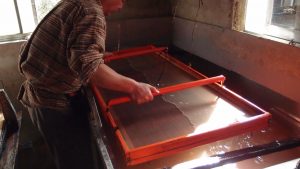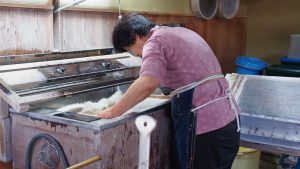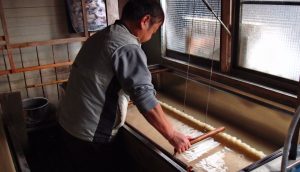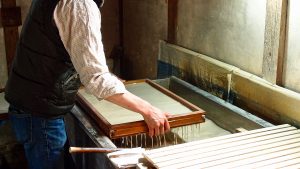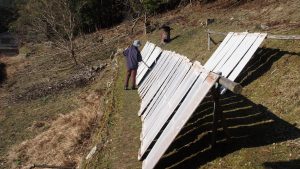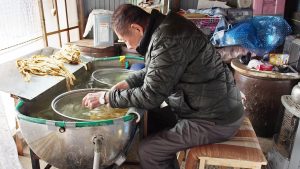In the past, artisans put Washi on wooden board for drying. This method was very much depending on weathers, and heavy tough work.
Roughly since a hundred years ago, drying on the warmed metal panel has permeated in Japan, then it became quite popular nowadays.
Though using the metal panel is convenient, drying on wooden board has meaningful effectiveness. That is less damage to the fibre. Drying on wooden board is harmonizing with the same speed of shrinkage with papers and excess water is absorbed. As a result, the fibre doesn’t break off, become strong and soft paper.
There are three styles of drying. First is "Sun Drying", under the sunshine. This is quite depending on weather, they can not dry the paper in cloudy, rainy and snowy day. This method gives also whiteness to the paper. Second is "Chamber Drying", which is popular in Echizen. They use the special room in the workshop, warmed and dried room. Third is "Indoor Drying", just drying the paper as it is in the room.
Gingko is the most popular material, because the surface is very smooth. Marronnier is similar, but a bit rare. Pine is also used, it makes wood pattern on the paper. Some of workshops are using very old board, more than 100 years old, inherited from the previous generations.
Some artisans dry the papers on metal panel at the natural temparature, under sunshine or indoor. It gives special smooth surface on the paper.
These methods are very rare at present. But we wish this method will be conveyed for the future.
Related Topics
Process: Nagashi-zuki (Kami-suki #1)
Nagashi-Zuki (流し漉き) is the most commonly-used method of Washi making. It was developed roughly 1,000 years ago. In this method, an artisan shakes the mould (sugeta) intensely. The manner of shaking horizontally and vertically depends on the kind of paper being made. This method is effective for making strong paper, […]
Read MoreProcess: Subuse (Kami-suki #4)
Subuse is a special rare method of Washi making, inherited by only two workshops in Yoshino. The artisan scoops the fibre solution with the mould and shakes it, then immediately pastes it on a wooden board directly, skipping the paper layering phase. Because many boards are required, and carrying them […]
Read MoreProcess: Tome-zuki (Kami-suki #3)
Tome-Zuki is the hybrid method of Tame-zuki and Nagashi-zuki, so it is called also Tame-Nagashi-Zuki. ”Tome” means “Keeping” or “Stopping”. The artisan scoops the fibre solution from the vat, then shakes the mould and waits for a while until the material drains. The timing is not strictly defined, and only […]
Read MoreProcess: Tame-zuki (Kami-suki #2)
Tame-zuki(溜め漉き) is an old-style, slightly rare method of Washi making. It is similar to the papermaking methods used outside of Japan. “Tame” means “Collecting”, and in this case refers to the material, fibre solution. The artisan doesn’t intensely shake the mould (Sugeta). They just scoop the fibre solution from the vat […]
Read MoreProcess: Ita-boshi (Wooden Board Drying)
In the past, artisans put Washi on wooden board for drying. This method was very much depending on weathers, and heavy tough work.Roughly since a hundred years ago, drying on the warmed metal panel has permeated in Japan, then it became quite popular nowadays.Though using the metal panel is convenient, […]
Read MoreProcess: Chiritori (Speck Removing)
Through the process of Washi making, artisans take most of the time, almost more than half, for speck removing. It is called “Chiri(塵=Speck/Dirt)-Tori(取り=Removing)”.Every artisan says “This is the most important process”. Not only to clean the material but also to understand the condition of the material. Even it is very […]
Read More







